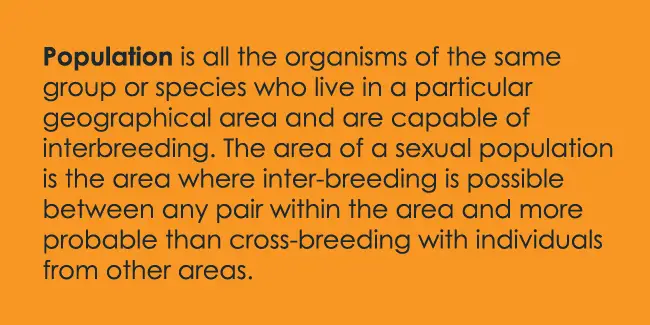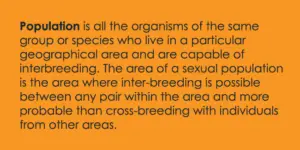
Let’s See What Population Conveys To Us In Biology.
The population is a collection of organisms of the same species, that live in the same place at the same time, with the capability of interbreeding. A species is a set of beings with similar biological characteristics, which can interbreed, creating fertile offspring.
Population ecology is the study of how the population interrelates with the environment. It is the dynamics of the population. However, It influences the division and plentiful of plant and animal populations. In ecology, a set of local populations partially isolated from each other is called a metapopulation.

What are the Characteristics of the population?
The characteristics are as follows:
- Biotic potential: It refers to the maximum capacity of individuals in a population to reproduce under optimal conditions.
- Growth patterns: This refers to the type of graph that represents the growth rate of a population.
- Environmental resistance: It refers to the set of factors that prevent a population from reaching the biotic potential.
- Birth and mortality rates: These rates are determined by both the species and the conditions of the environment. It represents the number of individuals that are born per unit of time and the number that die per unit of time, respectively.
Types and examples of the population in biology
Various types are as follows.
- Family populations: It refers to those populations that establish according to the degree of inbreeding. Those in which the kinship bond is central and common among the individuals that make them up, that is, they are all family. An example of this is the populations of cats such as lions.
- Gregarious populations: They are those populations in which individuals gather and mobilize without obeying the relationship. It forms by the massive displacement of individuals, who do not need to relate but come together for reasons of security and economy of resources. An example of this is the school of fish.
- Colonial populations: It is that group of individuals from a primitive one, to which it normally attaches. They form from a primitive individual, to which they remain attached as a general rule. These types form colonies. Examples of this are jellyfish, corals, or moss.
- State populations: Those whose members have a high degree of diversification and specialization, dividing the tasks and not being able to live in isolation and individually. Examples of this are social insects such as bees, termites, and ants.
Examples:
Some simple examples of the population describe below:
1. A pride of lions made up first of all of the male and female, who have numerous offspring, and which in many cases can be made up of several females and a dominant male. The human family is also an example. Shoals of fish, to which individuals are added regardless of their parentage or genetic origin.
2. The ideal example of this is an ant hive. Within which numerous individuals coexist, each endowed with very specific functions. Workers, soldiers, fertilizing males, and a queen that lays eggs. None of them can live separately. While A good example is the coral populations at the bottom of the seas.
Population density
Population density which represents the number of individuals that coexist per unit area, an indicator of the geographic availability of resources. It has to do with how concentrated the individuals that compose it are in the specific area of their habitat. This is usually measured in individuals per unit area.
Thus, when the population density is low, that is a few individuals per square kilometer. There will be a lot of surface between one individual and another, making it more difficult to find them. On the other hand, when the population density is high, it will be easier to get an individual.
They will be closer to each other since there will be more in the same unit of space.
You may also enjoy reading: